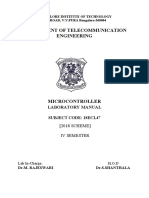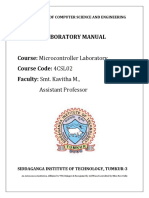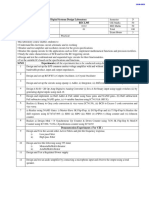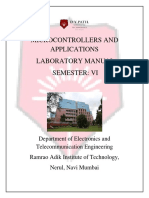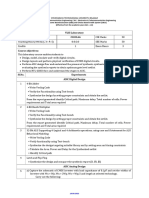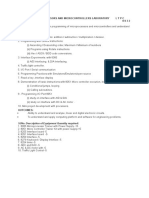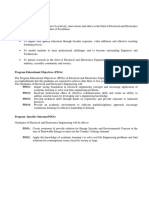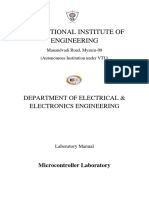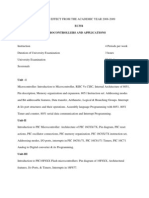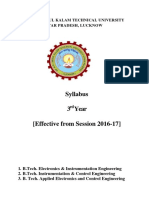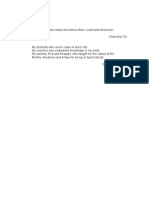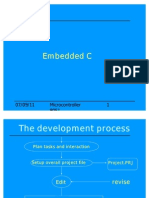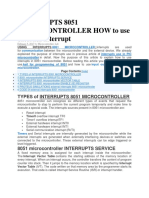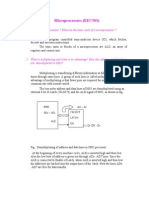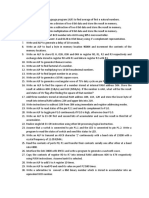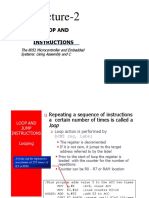Microcontrollers Lab Semester 4
Course Code BEC456A CIE Marks 50
Teaching Hours/Week (L:T:P) 0:0:2 SEE Marks 50
Credits 01 Total Marks 100
Exam Hours 2
Examination type (SEE) Practical
Course objectives: This course will enable students to:
Understand the basic programming of Microcontrollers.
Develop the 8051 Microcontroller-based programs for various applications using Assembly
Language & C Programming.
Program 8051 Microcontroller to control an external hardware using suitable I/O ports.
Note Execute the following experiments by using Keil Microvision Simulator (any 8051 Microcontroller
can be chosen as the target) and Hardware Interfacing Programs using 8051 Trainer Kit.
Sl.No I. Assembly Language Programming
Data Transfer Programs:
Write an ALP to move a block of n bytes of data from source (20h) to destination (40h) using
1
Internal-RAM.
2 Write an ALP to move a block of n bytes of data from source (2000h) to destination (2050h) using
External RAM.
3 Write an ALP To exchange the source block starting with address 20h, (Internal RAM) containing
N (05) bytes of data with destination block starting with address 40h (Internal RAM).
4 Write an ALP to exchange the source block starting with address 10h (Internal memory), containing
n (06) bytes of data with destination block starting at location 00h (External memory).
Arithmetic & Logical Operation Programs:
Write an ALP to add the byte in the RAM at 34h and 35h, store the result in the register R5 (LSB)
5 and R6 (MSB), using Indirect Addressing Mode.
6
Write an ALP to subtract the bytes in Internal RAM 34h & 35h store the result in register R5 (LSB)
& R6 (MSB).
7 Write an ALP to multiply two 8-bit numbers stored at 30h and 31h and store16- bit result in 32h and
33h of Internal RAM.
8 Write an ALP to perform division operation on 8-bit number by 8-bit number.
9 Write an ALP to separate positive and negative in a given array.
10 Write an ALP to separate even or odd elements in a given array.
11 Write an ALP to arrange the numbers in Ascending & Descending order.
12 Write an ALP to find Largest & Smallest number from a given array starting from 20h & store it in
Internal Memory location 40h.
Counter Operation Programs:
13 Write an ALP for Decimal UP-Counter.
14 Write an ALP for Decimal DOWN-Counter.
15 Write an ALP for Hexadecimal UP-Counter.
16 Write an ALP for Hexadecimal DOWN-Counter.
II. C Programming
1 Write an 8051 C program to find the sum of first 10 Integer Numbers.
2 Write an 8051 C program to find Factorial of a given number.
3 Write an 8051 C program to find the Square of a number (1 to 10) using Look-Up Table.
4 Write an 8051 C program to count the number of Ones and Zeros in two consecutive memory
locations.
III. Hardware Interfacing Programs
1 Write an 8051 C Program to rotate stepper motor in Clock & Anti-Clockwise direction.
2 Write an 8051 C program to Generate Sine & Square waveforms using DAC interface.
Course outcomes (Course Skill Set): At the end of the course the student will be able to:
@#25.04.2024
� Write a Assembly Language/ C programs in 8051for solving simple problems that manipulate input
1.
data using different instructions.
2. Develop Testing and experimental procedures on 8051 Microcontroller, Analyze their operation
under different cases.
3. Develop programs for 8051 Microcontroller to implement real world problems.
4. Develop Microcontroller applications using external hardware interface.
Assessment Details (both CIE and SEE)
The weightage of Continuous Internal Evaluation (CIE) is 50% and for Semester End Exam (SEE) is
50%. The minimum passing mark for the CIE is 40% of the maximum marks (20 marks out of 50) and
for the SEE minimum passing mark is 35% of the maximum marks (18 out of 50 marks). A student shall
be deemed to have satisfied the academic requirements and earned the credits allotted to each subject/
course if the student secures a minimum of 40% (40 marks out of 100) in the sum total of the CIE
(Continuous Internal Evaluation) and SEE (Semester End Examination) taken together.
Continuous Internal Evaluation (CIE):
CIE marks for the practical course are 50 Marks.
The split-up of CIE marks for record/ journal and test are in the ratio 60:40.
Each experiment is to be evaluated for conduction with an observation sheet and record write-up.
Rubrics for the evaluation of the journal/write-up for hardware/software experiments are designed
by the faculty who is handling the laboratory session and are made known to students at the
beginning of the practical session.
Record should contain all the specified experiments in the syllabus and each experiment write-
up will be evaluated for 10 marks.
Total marks scored by the students are scaled down to 30 marks (60% of maximum marks).
Weightage to be given for neatness and submission of record/write-up on time.
Department shall conduct a test of 100 marks after the completion of all the experiments
listed in the syllabus.
In a test, test write-up, conduction of experiment, acceptable result, and procedural knowledge
will carry a weightage of 60% and the rest 40% for viva-voce.
The suitable rubrics can be designed to evaluate each student’s performance and learning ability.
The marks scored shall be scaled down to 20 marks (40% of the maximum marks).
The Sum of scaled-down marks scored in the report write-up/journal and marks of a test is the total
CIE marks scored by the student.
Semester End Evaluation (SEE):
SEE marks for the practical course are 50 Marks.
SEE shall be conducted jointly by the two examiners of the same institute, examiners are appointed
by the Head of the Institute.
The examination schedule and names of examiners are informed to the university before the conduction of
the examination. These practical examinations are to be conducted between the schedule mentioned in the
academic calendar of the University.
All laboratory experiments are to be included for practical examination.
(Rubrics) Breakup of marks and the instructions printed on the cover page of the answer script to be
strictly adhered to by the examiners. OR based on the course requirement evaluation rubrics shall be
decided jointly by examiners.
Students can pick one question (experiment) from the questions lot prepared by the examiners jointly.
Evaluation of test write-up/ conduction procedure and result/viva will be conducted jointly by examiners.
General rubrics suggested for SEE are mentioned here, writeup-20%, Conduction procedure and result in -
60%, Viva-voce 20% of maximum marks. SEE for practical shall be evaluated for 100 marks and scored
marks shall be scaled down to 50 marks (however, based on course type, rubrics shall be decided by the
examiners)
Change of experiment is allowed only once and 15% of Marks allotted to the procedure part are to be made
zero. The minimum duration of SEE is 02 hours
Suggested Learning Resources:
“The 8051Microcontroller: Hardware, Software and Applications”, V Udayashankara and M S
st
Mallikarjuna Swamy, McGraw Hill Education,1 edition, 2017.
@#25.04.2024






